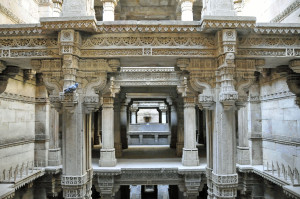Weather on the Indian subcontinent is characterized by periods of intense rain followed by long periods of drought. Because the soil is usually not suitable for reservoirs, Indians in the fifth century began building structures with hollow stone shafts extending up to 50 feet below the surface. Steps led from the surface to the shaft’s bottom, with periodic landings allowing people to congregate on various levels. When the rains came, the structure filled with water and people drew water and bathed near the top. As water was consumed, people descended the steps until they reached the water level. Because Hindus believe waters create a boundary between earth and heaven, representations of gods and other religious symbols on the landings enabled people to engage in underground religious ceremonies surrounded by water.
The Adalaj stepwell near Ahmedabad, Gujarat, is one of the most famous, both for its design and the story of its origins. According to Sanskrit writings on a marble slab near the bottom, the Adalaj stepwell was begun by a Hindu king named Veer Singh who was killed in battle by a Muslim leader named Mohammed Begda. Begda took over the kingdom and pined for the king’s widow, the beautiful Roopba. Roopba promised Begda she would marry him but only if he first completed her husband’s stepwell. Begda completed the project in 1499, with an octagonal shaft lavishly covered with both Hindu and Islamic images extending five stories below the surface. With Roopba’s goal of honoring her husband accomplished, she then jumped to her death in the shaft.
India’s stepwells were abandoned when the English declared them unsanitary, but many have been restored. The next time you get to India, look down after you have seen the Taj Mahal and the famous temples. Not all stepwells come with a legendary story, but all reflect the ingenuity of Indian architects.

Comments are closed.